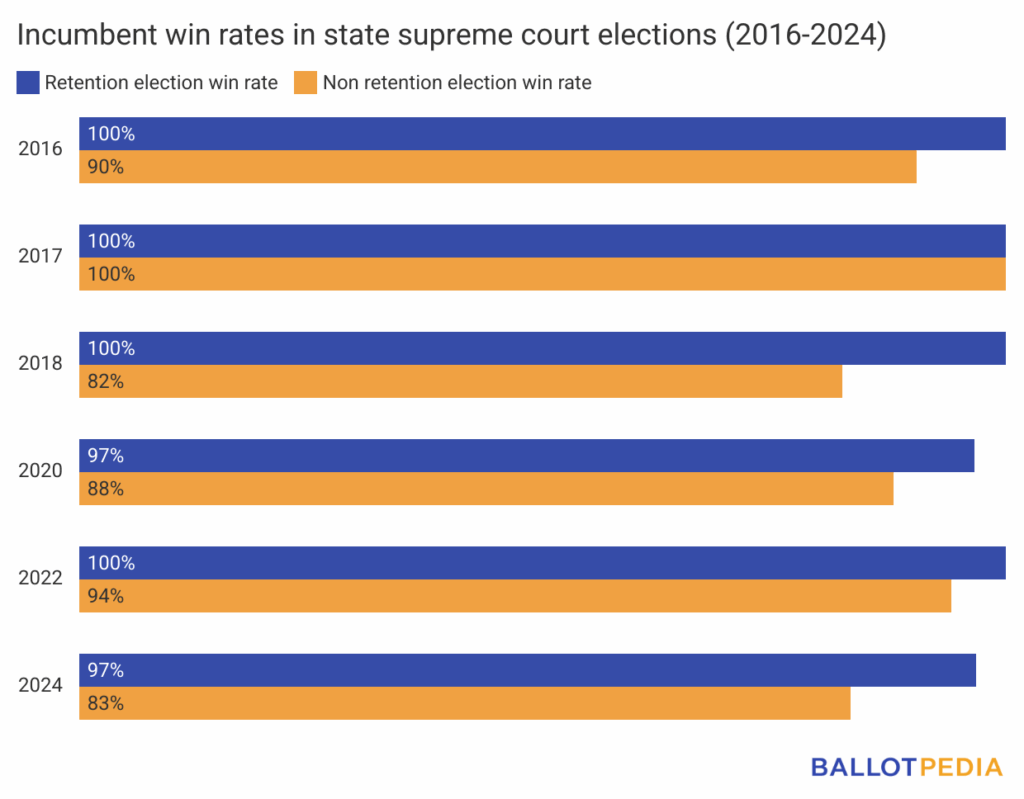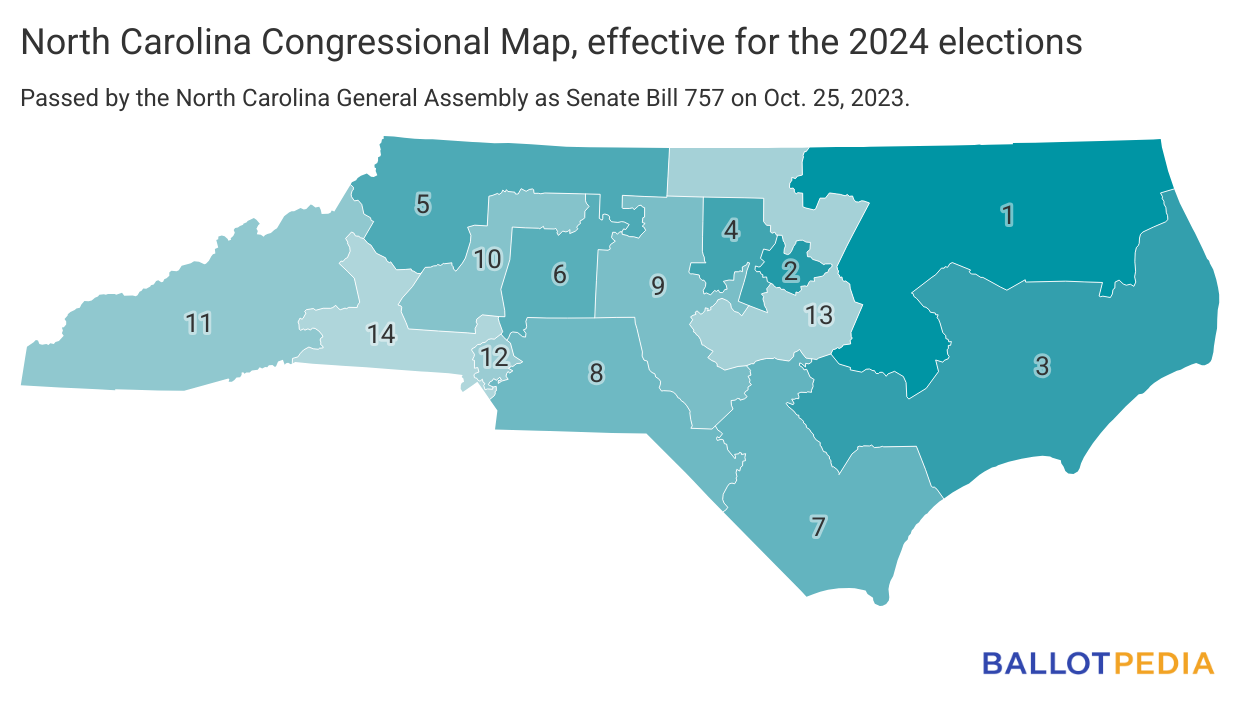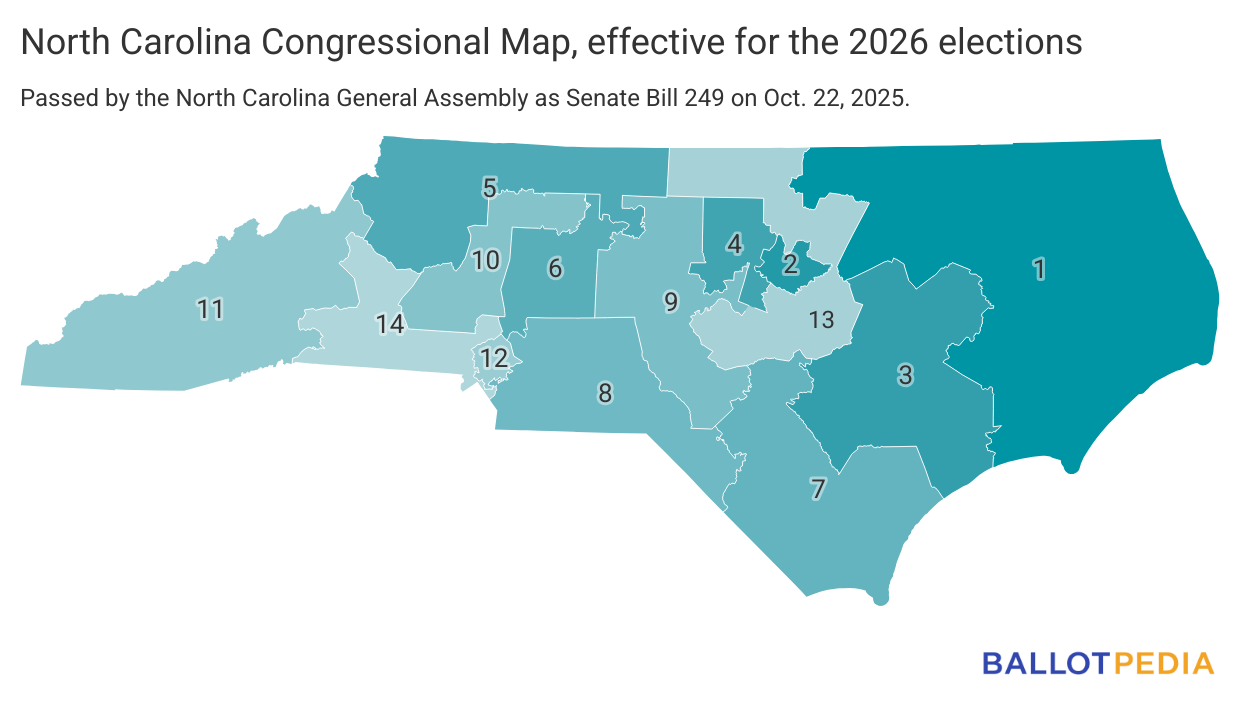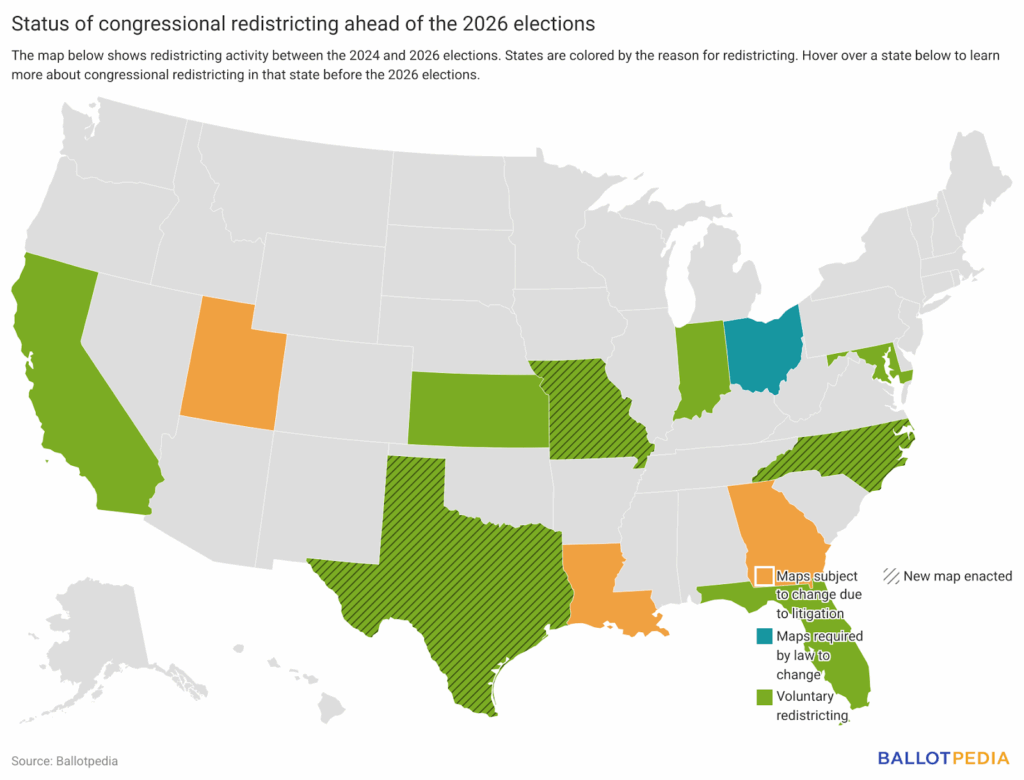Daily Brew: October 28, 2025
Welcome to the Tuesday, Oct. 28, 2025, Brew.
By: Lara Bonatesta
Here’s what’s in store for you as you start your day:
- A look at elections for downballot state offices in 2025
- North Carolina becomes third state to redraw its congressional maps ahead of 2026
- A look at where the candidates for New Jersey Governor stand on K-12 education
A look at elections for downballot state offices in 2025
There is one week to go until Election Day, and Ballotpedia will cover more than 10,000 elections on Nov. 4. To help our readers understand what’s at stake, the Daily Brew will feature previews of key elections from now through Election Day. To see what elections we're covering in your area, check out our Sample Ballot Lookup Tool.
Today we’re looking at elections for downballot statewide offices, including those for state supreme court and public service commission. Click below to see our previews on:
State Supreme Court
In Pennsylvania, three Democratic justices—Christine Donohue, Kevin M. Dougherty, and David N. Wecht—are up for a retention vote.
Both the Democratic and Republican parties have been involved in this race. The Republican State Leadership Committee is running ads on social media, asking voters to vote against retaining the justices. According to the Associated Press, the committee reported spending about $500,000 on digital ads and text messages. The Republican National Committee is also asking voters to vote against retention. The Democratic National Committee spent six figures in the final weeks of the race, and Democratic politicians, including Gov. Josh Shapiro (D), Sen. Elissa Slotkin (D-Mich.), and Rep. Chris Deluzio (D), have campaigned in favor of retention.
ABC News’ Emily Chang wrote, “Typically, these off-year races fly under the radar. But this particular race may have national implications as it could potentially influence the 2028 presidential election -- especially with the state's high court expected to preside over cases like election litigation and redistricting.”
The state court has a 5-2 Democratic majority. Democrats have had a majority since these three justices won their first election in 2015. If voters do not retain a justice, Shapiro, with approval from two-thirds of the Republican-controlled Pennsylvania Senate, can appoint a temporary replacement until 2027, when an election would be held for a permanent replacement.
The only Pennsylvania justice to lose a retention election was Russell Nigro (D) in 2005.
Since 1990, a total of 327 state supreme court justices nationwide have faced 575 retention elections. Voters retained 318 justices and voted nine out, for a retention rate of 97.2%.
The following chart shows how incumbent state supreme court justices fared in retention elections and non-retention elections in recent years. Click here to learn more.

Nationally, the last state supreme court justice to lose a retention election was Oklahoma justice Yvonne Kauger in 2024.
Public Service Commission
Georgia is holding its first election for Public Service Commission in three years following lawsuits over the election’s use of districts for statewide voting. Two of five seats are up for election on Nov. 4. Currently, all five commissioners are Republicans.
The commission regulates the state's utility services, such as electricity, phones, and gas. While the position is elected statewide, candidates must live in the district they are running in. The commission makes decisions by majority vote.
Candidates are running in two districts. Incumbent Tim Echols (R) and Alicia Johnson (D) are running in the Athens and Savannah-based 2nd District, while incumbent Fitz Johnson (R) and Peter Hubbard (D) are running in the Atlanta-metro-based 3rd District. Echols was first elected in 2010, and Johnson is a nurse. Governor Brian Kemp (R) appointed Johnson to the commission in 2021, and Hubbard works in renewable energy development.
Tim Echols, Alicia Johnson, and Peter Hubbard completed Ballotpedia’s Candidate Connection survey. Click here to read their responses.
Ballotpedia describes the offices of governor, lieutenant governor, attorney general, and secretary of state as top-ballot state executive offices. There are two non-gubernatorial top-ballot state executive elections happening on Nov. 4.
Virginia Lieutenant Governor
Ghazala Hashmi (D) and John Reid (R) are running in the general election for lieutenant governor of Virginia. Incumbent Lt. Gov. Winsome Earle-Sears (R) is running for governor.
WAMU's Margaret Barthel wrote, "Virginia's lieutenant governor has few official powers. The role presides over the state senate and can break a tie if the body is evenly split on a vote. The position also serves on a variety of state boards and commissions, and pays a salary of just over $36,000. But because Virginia governors can't serve consecutive terms, the lieutenant governor post is often seen as a political stepping stone to a future bid for governor."
Currently, Democrats have a 21-19 majority in the Virginia Senate.
Virginia Attorney General
Incumbent Attorney General Jason Miyares (R) and Jay Jones (D) are running for an office Republicans won by 0.8 percentage points in 2021.
University of Virginia's Larry Sabato said, "Jason Miyares is the incumbent, which means Jay Jones has a tough race automatically against an incumbent. But go back four years: Miyares beat the Democratic incumbent. How? He had coattails from Youngkin." Sabato said that in the election, "The greatest threat to Jason Miyares is not really the Democratic nominee. It's Donald Trump. It's coattail."
To read more about state supreme court elections in 2025, click here. To read more about statewide downballot elections in 2025, click here. Plus, make sure to check out the Daily Brew in the coming days to catch our other election previews.
North Carolina becomes third state to redraw its congressional maps ahead of 2026
On Oct. 22, North Carolina became the third state to redraw its congressional map ahead of the 2026 elections. According to the New York Times' Eduardo Medina, the new map aims to shift the 1st Congressional District, which U.S. Rep. Donald Davis (D) currently represents, toward Republicans. Based on the 2024 presidential election results, that means the redraw could change the state’s representation in the U.S. House of Representatives from 10 Republicans and four Democrats to 11 Republicans and three Democrats.
North Carolina joins Missouri and Texas in redrawing their congressional district lines. Missouri redrew parts of the Kansas City area in hopes of netting one additional Republican district. Texas’ redraw aims to net five additional Republican districts. In total, based on the 2024 election results, the redrawn maps would add a net seven new Republican congressional districts nationwide.
The North Carolina Senate approved the map 26-20 on Oct. 21, and the state House followed on Oct. 22 in a 66-48 vote. Both votes were along party lines, with Republicans voting in favor of the map and Democrats voting against it. Redistricting bills in the state do not require gubernatorial approval and are not subject to a veto.
The Daily Tar Heel’s Sarah Clements wrote, "The new map shifts six reliably-Republican counties — Beaufort, Carteret, Craven, Dare, Hyde and Pamlico — to historically-Democratic District 1. Additionally, it moves four counties previously in District 1 to safely-Republican District 3, including Greene County, where Davis is from.”


Mid-decade redistricting ahead of the 2026 elections
Congressional district boundaries could change in several more states before 2026.

A new congressional map that could generate five new Democratic districts will appear on the ballot as Proposition 50 in California on Nov. 4. Based on the 2024 presidential election results, there are five proposed districts that would become more Democratic, four of which Kamala Harris (D) would have won. Voters will decide in that special election whether to approve a constitutional amendment that would allow the Legislature’s proposed redraw to take effect through 2030. Approval of that plan, along with enacted changes in North Carolina, Missouri, and Texas, would result in a nationwide net gain of three districts for Republicans.
Ohio is legally required to pass a new congressional map because the state constitution places a shorter expiration date on maps that are passed without bipartisan support, as was the case for the state’s current map. If the redistricting commission does not approve a bipartisan map by the end of October, the Legislature can pass a map by a simple majority in November. Commission Chair Rep. Brian Stewart (R) said the three districts represented by Democratic U.S. Reps. Marcy Kaptur, Emilia Sykes, and Greg Landsman are “the most hotly contested races generally” and “are probably the seats that are most discussed when we're talking about whether there's going to be a deal."
On Aug. 25, Utah Third Judicial District Court Judge Dianna M. Gibson ordered Utah to redraw its congressional map. The Legislature and the plaintiffs in the case each submitted their proposed redraws for the judge’s consideration. The Salt Lake Tribune’s Robert Gehrke wrote, “The outcome will determine whether voters will cast their ballots next year in four districts that favor GOP candidates or if there will be at least one district that could be won by a Democrat.”
Several more states are reportedly considering mid-decade redistricting:
- The Florida House launched a Select Committee on Congressional Redistricting.
- Indiana Gov. Mike Braun (R) said a special session was likely, though state Senate Republicans announced that “the votes aren’t there for redistricting.”
- Kansas Republicans are gathering signatures for a special session on redistricting.
- Democratic legislative leaders in Maryland have expressed support for redrawing the state’s congressional map.
- Virginia Democrats reportedly plan to pursue a redraw that could create two or three new Democratic districts. To learn more about the plan in Virginia, check out our recent episode of On The Ballot.
Click here to learn more about redistricting ahead of the 2026 elections. Plus, check out our Oct. 3, episode of On The Ballot to learn more about partisan redistricting efforts around the country.
A look at where the candidates for New Jersey Governor stand on K-12 education
A version of this story appeared in Ballotpedia’s Hall Pass, our newsletter dedicated to school board politics and education policy, on Oct. 22. Click here to sign up.
There are two gubernatorial offices on the ballot this year — in Virginia and New Jersey. In both states, the incumbents are term-limited.
Last week, we looked at what Abigail Spanberger (D) and Winsome Earle-Sears (R), the candidates running for governor in Virginia, have said on K-12 education. Today, we’re looking to the Garden State.
Mikie Sherrill (D), Jack Ciattarelli (R), Vic Kaplan (L), and Joanne Kuniansky (Socialist Workers Party) are running to succeed incumbent Gov. Phil Murphy (D).
Sherrill was elected to represent New Jersey's 11th Congressional District in 2018. Before her election, Republicans had represented the district since 1985. Sherrill previously worked as a lawyer in private practice and the U.S. Attorney's office for the District of New Jersey.
Ciattarelli represented District 16 in the New Jersey General Assembly from 2011 to 2018. He served on the Raritan Borough Council from 1989 to 1995 and the Somerset County Board of Commissioners from 2007 to 2011. This is Ciattarelli's third bid for governor after running unsuccessfully in 2017 and 2021.
The New York Times’ Tracey Tully wrote that the “race is considered particularly competitive. Democrats hold a sizable registration advantage, but Mr. Trump fared far better in the state than expected last November, buoying Republican hopes.”
Sherrill has made student mental health and tutoring cornerstones of her plan. Sherrill said she’ll introduce “legislation to provide high-quality tutoring to students” and increase the number of school counselors and mental health services in schools. Sherrill has also said she’d make school meals free for all students.
Ciaterrelli has focused on providing families with more educational choices in and out of the public school system, combating teachers' unions, and working with the New Jersey Department of Education to raise achievement levels at low-performing schools.
Sherrill and Ciaterrelli disagree on the Trump administration’s moves to reduce the number of employees working in the U.S. Department of Education. Sherrill said, “The dismantling of the Department of Education is [a] huge issue and we’re going to see a huge hit come into [the] state budget. It’s why I fought so hard to say we’re going to claw back that money.”
Ciaterrelli said, “I don’t necessarily have [a] problem with the president and the administration downsizing the Department of Education.”
Sherrill and Ciattarelli have said they support changing the state’s funding formula. Sherrill said the formula “was not totally fair—it doesn’t put more into the districts that have more people with learning disabilities, for example.”
Ciattarelli said, “I have a very specific plan on how to lower property taxes. We need a new school funding formula. A more equitable one will help lower the property tax.”
Both Sherrill and Ciattarelli support expanding the Interdistrict Public School Choice Program, which allows students to transfer to schools in a different school district.
During a Sept. 24 debate, Sherrill said she supported expanding charter schools. But aside from that comment, Sherrill has said little about charter schools. Ciatterelli, on the other hand, has made charter school expansion a central part of his education plan, saying, “As Governor, I would be a strong proponent of school choice and charter school expansion.”
Sherrill has not released a public statement on private school choice programs, but has said she would “fully fund our schools so every kid, regardless of what language they speak or what ZIP code they are in, has access to a high-quality public school education.” Ciattarelli said “I’m an educational choice guy. We need vouchers like we’ve seen with success in Arizona, Ohio, and Florida.” Ciattarelli also said he would opt the state into the federal K-12 education tax credit created through the One Big Beautiful Bill Act earlier this summer.
New Jersey is one of 14 states without state-level policies governing student cellphone use in K-12 public schools.
Sherrill said she would support a bill banning cellphones in classrooms. Ciattarelli said he supports limiting student access to cellphones during class time but believes the policies should be determined at the district level.
New Jersey voters have not elected a member of the same party for three consecutive gubernatorial terms since 1961. However, in eight of the 10 gubernatorial elections from 1985 to 2021, voters elected a governor from the opposite party of the president.Click here to read more about the New Jersey gubernatorial election.


